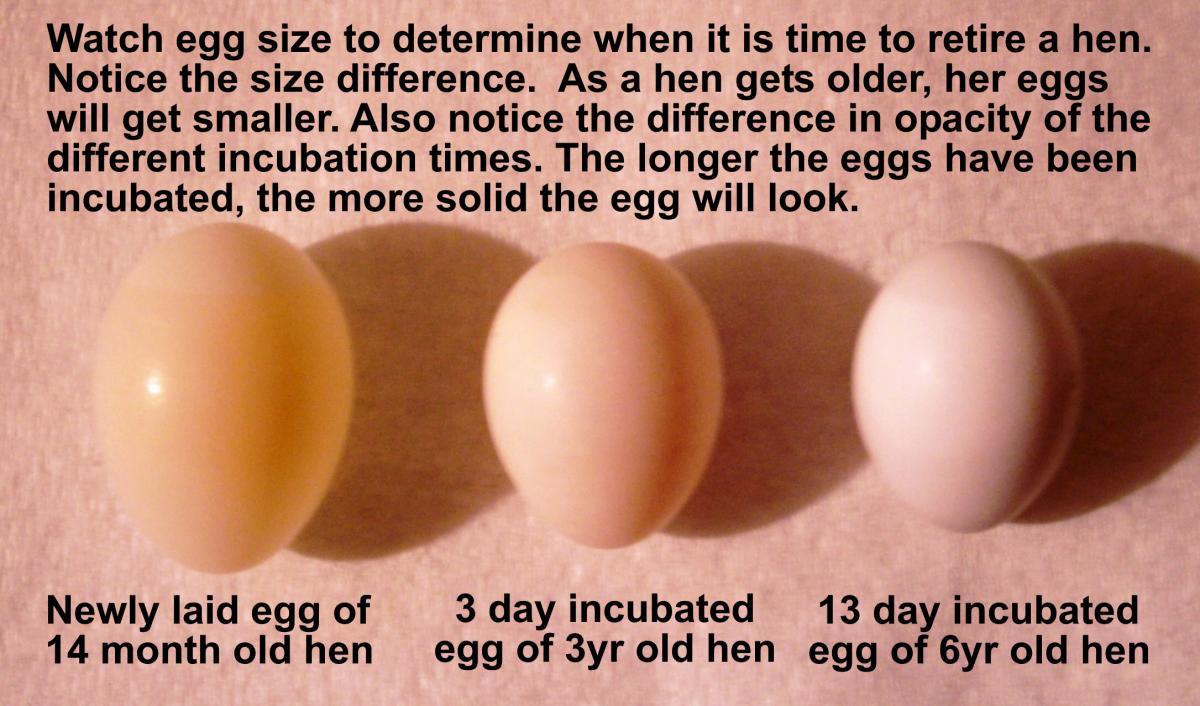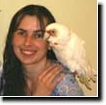You Have Eggs!
Kristen Reeves, Meadowlark Farms Avian Supply, Inc.
Your Gouldians have chosen a nesting site and have begun to lay their eggs. What do you do now???
If you know your pair has been courting and are now spending time in the nest, chances are the hen is laying eggs or preparing to. In my aviary, eggs are typically laid five days after the first copulation. Hens usually start brooding after the third egg is laid, though some of my hens will brood immediately and others will wait until the entire clutch is laid. Some breeders will pull the eggs as they are laid and replace them with dummy eggs, then replace all real eggs once the clutch is complete to ensure all eggs hatch on the same day or within a day of each other. I do not do this. I let the eggs hatch as they may.
If you think your hen is brooding (sitting for long periods and not leaving the nest except to eat, drink and relieve herself), check the nest for eggs. The best time to do this is usually first thing in the morning when the pair leaves the nest to relieve themselves and eat. But don't peek too often! If your birds are not accustomed to your hands in the cage constantly like mine are, or you are inexperienced at handling the birds and eggs, you don't want to upset them and have them abandon their nest.
Don't be surprised if you see the cock sitting in the nest box with the hen! And don't be surprised if they don't brood until all eggs are laid!
AVERAGE CLUTCH & EGG SIZE:

Average egg size is between 17mm & 19mm

An average clutch is usually 4 to 6 eggs though I've had hens lay as few as two and as many as 13 or more. Unless you have an "exceptional" pair, the parent birds will not usually be able to care for more than 6 chicks without detriment to the health of both themselves and their chicks. For a clutch larger than 6 eggs, I will usually remove eggs and foster them under another Gould or Society pair, though I prefer to place them in an incubator and hand-feed the chicks once they hatch.
CANDLING & REMOVING INFERTILE EGGS:
When you "candle" an egg, you hold a very bright light called an Egg Candler to the egg and look for signs of life. If the hen has been brooding consistently, signs of viability typically begin to show at 3 days . At that 3 day mark, you should see a tiny red circle or “comma shaped” blob often surrounded by a very fine mesh of blood vessels. If you've waited until about day 5 after the egg was laid and your hen is brooding regularly, you should see a tiny heart beat. You won't usually see larger blood vessels around the yolk until a little later, but if the hen has been brooding tight, you may see more than you expect! The longer fertile eggs are consistently brooded, the more growth you will see. Eventually you may even see the chick moving or opening and closing its beak! If you wait to candle beyond day 6-10, chances are you won't be able to see anything but darkness filling the egg. This means the chick is growing and filling up most of the egg.
A Note of Caution: It has been said that candling too often can injure the chick. Using a high intensity light can damage their eyes or overheat them and kill them in the shell. Therefore, once you have candled the eggs and know they are fertile it is best not to candle them again unless you suspect they are not going to hatch.
For more information about egg fertility and infertile eggs, please see our "Determining Egg Fertility" article.
WHEN THEY HATCH:
In my aviary, I track eggs from the date they were laid. Eggs typically begin to hatch 18 days from the day the egg was laid, but that allows for errors in calculating when the hen began brooding consistently. Incubation takes 13-15 days. My hens typically begin to brood after the 3rd egg is laid meaning they will hatch 18 days from the date the first egg was laid.
When the eggs are ready to hatch, the parents may begin to act a little funny. They may be bopping about or jumping in and out of the nest. They may make enough noise to get your attention with their beeping and calling. Or they may do nothing more than sit tight in the nest. My birds all act the same - they get weird! They can hear the tiny chicks peeping from inside the egg and know it's time for them to hatch.
The parents may assist the chicks out of the eggs by pecking carefully at the shell. They will then either toss the shell out of the nest or eat it. This is not unusual.
You need not intervene unless you suspect there is real trouble! Real trouble could be a chick in distress while trying to emerge from the egg, or the parents pecking at the chick or even tossing it out of the nest! Unless you see signs of trouble, it is best to leave the parents alone to take care of their chicks in peace. Personally, I never leave the house for more than a few hours if I think chicks are going to hatch. I want to be available to assist if necessary (another reason to keep good records and pay close attention!).
ASSISTING THE CHICK OUT OF THE EGG:
Occasionally, especially during the dry season for us humans (winter when the furnace is running or summer when the a/c is on), chicks may have a difficult time getting out of their shells. This is usually caused by a lack of humidity. When the humidity levels are too low, the egg membranes dry out too soon and do not allow the chick to "slide" out of the shell as it gets it cracked open.
In most cases, the parents will assist the chick, but on rare occasions you may need to help. If this is the case, wash your hands thoroughly, get your handy dandy plastic tweezers out, remove the egg from the nest and place it on a paper towel. Gently remove the egg shell from around the chick with the tweezers (or your fingers if you are steady enough). Once the chick is out of the egg, use warm, clean water and a cotton swab to remove any excess or dried membrane and return the chick to the nest. If you have an experienced pair of parent birds, returning the chick should not be an issue. If the parents toss the chick or abandon it, follow the directions for fostering or hand feeding the chick.
This is NOT something I recommend for the inexperienced breeder. Aiding a chick too soon can result in the death of the chick if the yolk has not been fully absorbed. Waiting too long can result in the death of the chick because the egg dries out and the chick becomes trapped. There is a very fine line between too soon and not soon enough. If you are not absolutely certain the chick is ready to hatch and is in distress, you should NOT try this.
There is a video attached at the end of this article showing a successful extraction - the chick survived because I accurately determined it was ready to hatch and aiding it would be best. This is not always the case. A chick with the yolk still outside the body rarely survives. In this case, the yolk had been fully absorbed and the chick survived the extraction.
ABANDONED EGGS OR CHICKS & FOSTERING:
Young parents, or those who have continually abandoned eggs or tossed eggs and chicks may require you to foster out the eggs or young if you wish to raise additional birds. If you've chosen your pairs wisely this should not happen. However, even parents who have never tossed or abandoned their nests may do so due to stress, too much commotion in the bird room, too many fingers in the nest box (peeking in too often), improper nutrition, etc. While we do not encourage fostering, the following are a few tips in case you have no other option.
Before you breed your Goulds you may want to have a "safety net". This means keeping a pair of foster parents ready in case of trouble. While I prefer to hand feed if necessary, I rarely need to use fosters for my Gouldians. However, I always keep a well prepared pair of Society finches available just in case. If I know I will have eggs hatching and will not have time to handfeed, the Societies could be the difference between survival or death for my chicks.
In the case of eggs, you can foster them out to another pair of more experienced Goulds who are already brooding (my first choice), you can place the eggs in an incubator and hand feed once the chicks hatch, or you can use foster parent birds of another species such as Society or Zebra finches.
A Society or Zebra pair could be your only hope of saving eggs or chicks if your Goulds continually toss chicks or abandon their nest. However, it is important that your fosters have been fed and conditioned the same way you've conditioned your Goulds for breeding. You want them to be used to the nestling diet you want fed to the Gouldian chicks. It is also a good idea to treat Zebra or Society foster parents with an antiprotozoal medication prior to the breeding season. Both Zebra and Society finches tend to carry protozoa that do not bother them but can potentially kill your Gouldian chicks. I recommend treating fosters with Ronivet 12% one week before any eggs to be fostered are due to hatch, then AGAIN one week AFTER the chicks hatch. This will keep any protozoa the fosters may be carrying in check and prevent an infection in the chicks.
NUTRITION, CONDITION & HOUSING:
Should you choose to foster, it is important that the foster parents be in the same "mode" as the Goulds. You must make sure the foster parents have been fed the same diet as the Goulds and are in top breeding condition. Nutrition is just as important for your foster parents as it is for your Goulds! Aside from proper nutrition, you want them used to the foods you want fed to the Gouldian babies so that the young Goulds thrive - such as soaked seed, sprouts, egg food, etc. You'll want to have set them up in a breeding cage of their own and allow them to begin to lay (some never lay but will foster anyway!).
I'd like to point out that due to the nature of both Societies and Zebras, you should only keep one pair of birds in the foster cage. Both these species are social birds and will sleep in the nest as groups. I have had 11 Society finches cram themselves into a small bamboo nest to sleep at night! You can imagine what could happen to a clutch of babies! They could be squashed or the eggs could be broken. If there are too many adult birds in the cage, chances are the eggs will be brooded inconsistently and may not hatch or may hatch late. In addition, Societies and Zebras are very curious by nature and will constantly peek into the nest distracting the foster parents from their job.
You can either replace the foster parent eggs with the Gould eggs, or allow the chicks to hatch alongside the Goulds. However, there is some conflict concerning this topic. Some breeders say you should not allow the Societies to raise their own chicks with the Gould chicks, others say they have not had any problems doing so - I do not allow Societies I intend to use as fosters to raise their own. I have found that once they raise their own, they don't feed other species as well or as consistently and attempt to wean far too soon.
There will also be the occasional breeder who is totally against fostering altogether! I personally prefer that my Gouldians are parent raised and would rather hand-feed than place chicks under fosters. I will not associate with breeders who merely use Societies to produce huge numbers of Gouldians and I certainly will not knowingly purchase a Society-raised Gouldian. The point is to keep PARENT RAISED chicks of QUALITY, not QUANTITY.
But remember, the choice is yours! If you'd prefer to have only parent raised Goulds, then don't foster. If you'd like to try to help the eggs or chicks survive when tossed or abandoned, foster them out! And if you have a pair that consistently tosses or abandons, it is best to remove them from your breeding program entirely.
FOSTERING IS NOT WITHOUT PROBLEMS:
One reason for this debate is that young birds are directly influenced by the parent birds, meaning if the Societies act like Societies, the fostered Gould chicks could conceivably think they are Societies too! This is called "imprinting". Goulds who are left too long with their Society fosters tend to think they are Societies and may not mate with other Gouldians. It is best to remove Gouldian chicks from a Society cage as soon as they are weaned.
I have also found that chicks fostered by birds other than Goulds are never as robust. Societies feed very differently than Gouldian parents. They tend to eat & feed less of the rich, high quality, high protein foods required by Gouldian chicks, and eat & feed more of the lesser quality nutrients such as millet right from hatching. Gouldians feed their chicks a fine crop milk with very little whole seed for the first 3-5 days while Societies feed whole millet right from hatching. Gouldian chicks cannot process such quantities of whole seed so young and may fail to thrive or be weaker and less robust than parent raised Gouldian chicks. Carefully preparing the birds you intend to foster by feeding them a richer diet well before they may be needed as fosters will help, but they still do not feed like a Gouldian parent would.
It's also been said that a fostered Gould will not raise it's own babies. I have not found this to be true, though I have not used Societies or Zebras except in rare instances. This brings us back to the point of choosing your pairs wisely. Only breed well suited, well conditioned, mature birds to help avoid breeding issues and avoid needing to foster.
NOTE: If you need to foster your eggs or chicks to another species, be aware that Society and Zebra young fledge and are independent of their parents well before Gouldian finch babies. If you notice that the Gouldian chicks are still begging but not being fed by the foster parents, remove one of the foster parents. One adult foster will usually continue to feed the babies for as long as they beg without issue.
ONCE WEANED:
At about 45-50 days, Gouldians begin to wean. A chick that no longer begs AT ALL is considered weaned. A chick that still begs - even occasionally - should never be removed from its parents OR foster parents. If you aren't sure if they are weaned, a good sign that chicks should be weaned or nearly weaned is when the nodules on either side of the beak begin to diminish. By the 45 day mark, the center nodule should have almost entirely dissolved. When there are only two nodules left on either side of the beak, you can be relatively certain the chicks are old enough to be weaned. However, only when the Gouldian young NO LONGER BEG AT ALL, are independent of the foster parents, and eating and drinking on their own should they be move to a large flight cage so they can build their flight muscles and get good exercise. They will also go through their juvenile molt - another dicey period for birds raised by Society fosters. A heat lamp and soft high protein foods should still be offered even once moved to a flight of their own.
FINAL WORD:
Gouldians who have been properly prepared to breed should produce fertile eggs and not abandon eggs or toss chicks. Once you have chicks in the nest, be sure to continue feeding the parents a good nestling food such a chitted seed mix, egg food or prepared nestling food to ensure good growth and promote health in the chicks. Nutrition is key - do not skimp on supplements or quality foodstuffs. If you get the nutrition right, you'll see very few issues in your chicks as they mature into adults!





